Life on the Move
Whether birds that crisscross the globe, whales that navigate the vastness of the oceans or wildebeast on the African savannas – the major animal migrations in our world present an incomparable spectacle. Yet in many cases, surprisingly little is known about either their exact destinations or how they get there. At the Radolfzell observatory of the Max Planck Institute for Ornithology, Martin Wikelski and his team use miniature transmitters to track a wide variety of species on their travels.
Text: Catarina Pietschmann
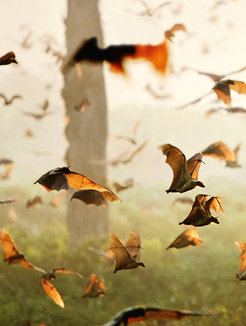
It is distinctly cool for an evening in May. The sun has just gone down and now the chilliness starts creeping up the spine. Beneath the eaves of the primary school in Konstanz, something is moving: a gentle rustling sound can be heard, overlaid by faint, high-pitched squeaks. Suddenly, it all happens very quickly: first one, then another, then five at once – they launch themselves in half-second intervals, dropping down in free fall almost to the ground before soaring back up, then shearing off to make room for the next one. These noctule bats are headed for the best feeding sites around Lake Constance. Tonight there are 89 of them. A few days ago there were 200. Some are already on their way to the far north, where midges and mosquitoes are far more numerous during the summer.
As part of their research at the Max Planck Institute for Ornithology, students from the University of Konstanz are out in the field in teams of two, armed with compasses and receivers. Days before, they helped bat expert Dina Dechmann fit several of the creatures with tracking tags. Now their task is to locate them and keep plotting their exact position. The rhythmic beeping of the transmitters is reminiscent of a heart monitor. Each bat sounds slightly different. The closer they are, the louder the tone. It’s going to be another long night. One team member takes the measurements, the other writes them down. Some will be on their feet until midnight, others until sunrise. No one knows what the night will bring – this is research with a touch of spookiness. Still, in teams of two, they aren’t alone.
“Bats, quite literally, live under the same roof as we do, but we know little about their migration routes,” says Dechmann. In addition to a transmitter, the creatures – which can live to be 10 to 12 years old – are also implanted with a microchip for recognition purposes. “Many of them migrate on a regular basis, while others stay here. The young ones don’t fly with their mothers. But how do they know where to go? And what the males do is completely unknown.”
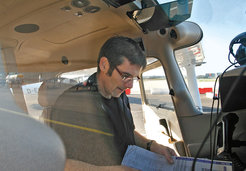
Martin Wikelski is the Director of the Radolfzell observatory, one of two locations operated by the Max Planck Institute for Ornithology. Wikelski switched from Princeton University to Radolfzell in 2008. He, too, is fascinated by animal migrations – whether by land, by water or by air. Besides various bird species, he has tagged giant tortoises in the Galapagos Islands, Monarch butterflies in the US, and agoutis, a rodent species that measures up to 65 centimeters in length, in Panama. He uses the latest telemetry to realize Alexander von Humboldt’s vision of “understanding the appearance of physical things in their own context, of understanding nature as a whole whose inner forces give it life and movement.”
For Wikelski, the planet is really just a single pulsating organism. “Animals are constantly on the move. Some over only short stretches, others over huge distances.” Back in Princeton, he developed the Movebank platform, a global animal migration database that is now used by researchers the world over to store data on the movements of animals in the wild. One click is enough to track the migration of gulls tagged in Finland and Russia all the way to Istanbul and Lake Victoria in East Africa. Or the comparatively short distances covered by agoutis in the rainforest.
Rodents spread tree seeds
These rodents eat the seeds of tropical trees, such as Brazil nuts, but they also bury some of them for hard times. The researchers therefore fitted nuts with transmitters and magnetic contacts. If a nut was moved, the magnet triggered an alarm. In this way, the biologists were able to track the nuts as they were carried from their native tree through the forest. In the course of a year, agoutis dug up and reburied one nut 36 times, wandering 600 meters through the rainforest as they did so. This also increases the chance that the nut will germinate and one day become a tree.
“We are familiar with perhaps one percent of the lives of animals in the wild, because up to now, it has been possible to observe them only sporadically,” Martin Wikelski explains. “But the animals carry our transmitters around their entire lives.” The tags not only measure time and place, they can also pick up temperature, acceleration, speed and even the animal’s heart rate. Given that each type of behavior entails typical patterns of acceleration, it is possible to conclude from the data what the animal is doing at any time. For example, the transmitters reveal how many pine needles a Capercaillie eats. For each species being tracked, the scientists discover new behavior patterns. “Basically, with this technology, we are also revolutionizing behavioral biology.”
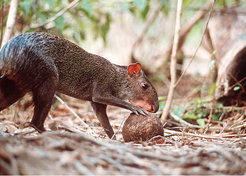
Many species carry plant seeds with them on their travels, thus making a significant contribution to biodiversity. Some seeds travel around the world in the digestive tract of migrating birds. Insects pollinate flowers as they move from one to another. Around-the-clock observation gives researchers a completely new picture of a species. Species such as the Venezuelan oilbird, once suspected of destroying seeds, have proven to actually be spreading them. This bird, which has such a high oil content that it can be rendered or dried and burned as a torch, was formerly regarded as a rainforest parasite. Oilbirds spend their days in caves, flying out at night to feed on fruits. Back at their roosts, they excrete the seeds, which had no chance of germinating – or so it was thought.
“We caught and tagged two birds with transmitters. The next morning, we entered the cave – but there were no birds!” Martin Wikelski recalls. “We caught a few more, and they didn’t come back, either.” They tried a third time, and to their surprise, on the following day, the birds tagged first were back again. “It’s a completely different story: They fly to a tree, eat some fruit, then settle down 100 meters away and spit out the seeds. That’s the first propagation. Then they move on to the next tree.” After their last meal, they head for a roosting tree that can be up to 80 kilometers away, where they scatter more seeds. Only then do they return to their cave.
According to past estimates, there were some 10,000 oilbirds living in the Humboldt cave in Venezuela. Now scientists believe there could be three times as many, given that birds spending the night in trees had not previously been counted. With the aid of their transmitters, the team from Radolfzell has succeeded in identifying what is in fact one of the main propagators of seeds on the slopes of the Andes in Amazonia.
Wandering pheasants in the himalayas
Wherever the researchers put their transmitters to work, they come upon something unexpected. Take, for example, the high-altitude wanderings of the Himalayan blood pheasants. These birds were tracked simply in order to discover whether all animal migrations follow similar natural laws. “We thought that when snow falls high up, or it gets too cold, they would move to lower altitudes. But some just walk three valleys further on and remain at the same height. And I really mean “walk”. They don’t fly; they literally walk up and down the mountains.” Wikelski has also observed black-necked cranes in Bhutan in order to understand how animals overcome huge ecological barriers. These cranes regularly migrate from China to the highest passes in the Himalayas and overwinter in Bhutan. Some even fly higher than the world’s highest mountain peaks. Aircraft have reported seeing black-necked cranes at an altitude of 9,000 meters. “We have no idea how they can even fly so high.”
Animals on their migrations can carry stowaways over long distances in their fur, feathers or digestive tract: parasites, fungi, bacteria and viruses, including some that can spread to humans and cause such diseases as borreliosis, SARS, rabies and bird flu. Sometimes it’s hard to say whether the very existence of a given species is good or bad for the environment. A beneficial contributor to biodiversity can also be a risk factor for humans and other species.
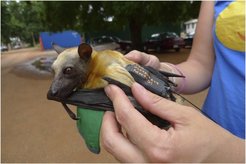
This applies in the case of the African fruit bats whose behavior Wikelski’s colleague Dina Dechmann has been studying in Ghana. Eidolon helvum, the straw-colored fruit bat, is a long-distance flyer capable of travelling 1,500 kilometers across the continent. They are also suspected of spreading disease. Some tribes consider them to be a delicacy with aphrodisiac properties, and try to bring them down with shotguns. This is one reason why the population has drastically declined.
“Earlier studies indicated that this was a key species for the African rainforest, because they are efficient distributors of seeds,” explains the Swiss biologist. Accordingly, 96 percent of the trees are thought to be the product of fruit bat excretions. This is an unusual fact, given that most fruit eaters either remain permanently below the canopy of the tropical trees that provide their food supply, or excrete directly in situ.
The straw-colored fruit bat, in contrast, has a somewhat sluggish digestion. And as in the case of the oilbird, a 100-kilometer flight for a feed is a mere bagatelle. In fact, after eating, the bats may even fly the same distance back home. Dina Dechmann and her team are currently studying a colony of around 300,000 of the creatures in Accra. “During migration, this species can easily cover up to 400 kilometers in one night. We are interested in whether and how the group members of this highly social species communicate with one another.”
Locating them is still an arduous process and is possible only when they stop to roost during the day. Solar-powered transmitters don’t work well with nocturnal animals, even though they spend their days suspended in trees. For this reason, the scientists are developing powerful new GPS transmitters that can send a permanent stream of data.
Observation posts in space
Transmitters of this type are of central importance for another of Martin Wikelski’s major projects: International Cooperation of Animal Research Using Space, or Icarus, for short. Year after year, billions of songbirds, bats, and even insects migrate over huge distances. The ecological effects of their migration patterns and how they affect climate change are still largely unknown.
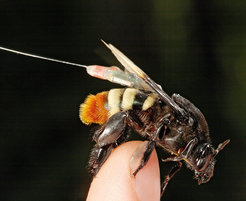
Modern sensors are so minuscule that even dragonflies can carry them in flight. “So we can even track insect migrations,” Wikelski explains. “In the future, we will be able to predict, for example, where locust swarms will occur in Africa.” High-tech is spearheading the fight against starvation. “Some people laugh at the name,” Wikelski grins. “You know what happened to Icarus!” That particular hero of Greek mythology met a tragic end: when he flew too close to the sun with his homemade wings, the wax melted and he fell into the sea – a hazard that certainly doesn’t apply to this project. Initially, the transmitters will send their data to the International Space Station, then later to satellites. The European Space Agency and the German Aerospace Center didn’t just give Icarus the green light, they also promised substantial funding. Also on board are the German Research Foundation and the National Science Foundation in the US, which will take care of the data analysis via the Movebank database.
A study of goats in Sicily has shown what huge benefits such data might have. The animals also act as biosensors with the ability to detect impending natural disasters. “Over six months, we tracked the movements of the animals up and down the slopes of Mount Etna.” Wikelski zooms in on a computerized map of the area surrounding the volcano. Clicking on the lines of movement reveals details of times and dates. The lines form a wild pattern in which steady traces are interspersed with brief zigzag intermezzos and violent peaks, representing overnight sleep intervals, wild leaps up- and downhill, feeding pauses and brief naps. Wikelski picks out a particular point. “Here! At 1:00 a.m. the goats suddenly and quite unexpectedly became very active. At around 7:00 a.m., the volcano erupted.” Even in ancient times, there are descriptions of animals behaving oddly before an earthquake.
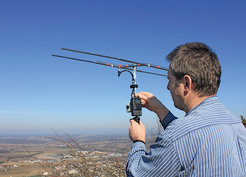
A “goat detector” for geological events – why not? After all, elephants detected the seaquake beneath the Indian Ocean long before the first tsunami wave reached the coast. Those locals who followed the fleeing pachyderms into the interior owe their lives to the animals’ instincts. An application has since been made to patent the idea of just such a biological early-warning system.
“How I would like to sit upon the back of the gander Martin on such a fine morning,” thought the boy. “How fine it would be to ride through the warm, still air up above where I could look down on the earth, spread with green grass and beautiful flowers!” Of course Martin Wikelski, as a child, also read Selma Lagerlöf’s stories about Nils Holgersson: fantastic tales of a boy who flew with the wild geese, mounted on the back of a tame gander. He grins. “Basically, that’s just what we are doing now! We mount an animal with a spyglass and fly along. Soon, tiny little cameras will even let us see what the animal sees.”





